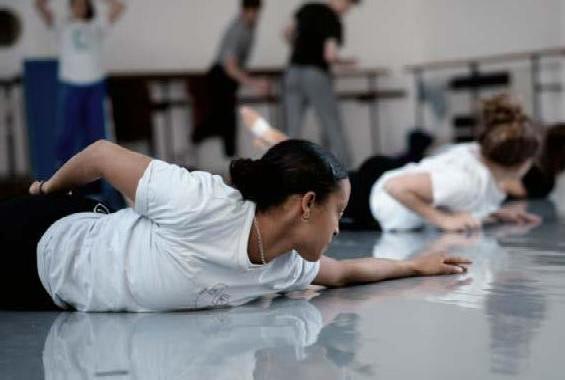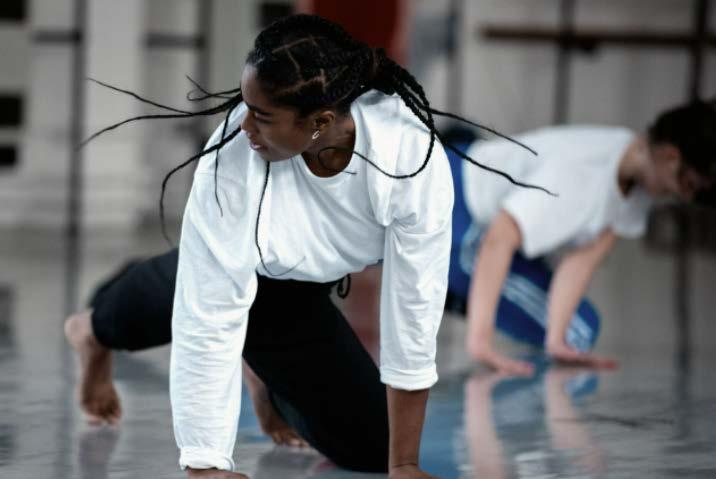
6 minute read
PLACING DIVERSITY FRONT AND CENTRE
The Place and London Contemporary Dance School (LCDS) look back on a 50-year history of paving the way within the dance industry, with innovation, internationalism and experimentation woven into its DNA.
Mining its past as a pioneering arts school, the organisation is looking to challenge the notion of what ‘contemporary’ means leveraging a mission to power imagination and a vision for a world with more dance.
PROGRAMME REVIEW
In preparation for the Periodic Programme Review in 2020 – an academic process to reinvigorate programmes every five years - the team spent two years taking time to listen to students, artists, audiences and industry leaders, to understand the conditions needed for change and to take on board what they wanted to see within the industry and within society.
“There was a real drive from our Chief Executive Clare Connor not to be afraid of the scale of change we were going to make; this allowed us to fully free our imagination. If we really want to make a difference, what do we need to do?”, asks Baptiste Bourgougnon, Director of Undergraduate Studies. “The new programme allows us to build on what we have learnt but put these ideas centre stage.”

© Camilla Greenwell, 2019 Graduation Show, Holly Blakey work
DIVERSITY OF DANCE STYLES
A central driver was the decentralising focus away from ballet and contemporary technique classes as the pinnacles of a hierarchical structure. LCDS is now introducing Kathak and hip hop classes, as well as practices from the African diaspora such as house, vogueing, locking and traditional African dance practices into the curriculum.
Dr Lise Uytterhoeven, Director of Dance Studies at LCDS
Another key factor in unlocking the change was a new validating partnership with UAL, University of the Arts London. UAL’s Creative Attributes Framework and its structure of broad-stroke units rather than strict modules with specific learning outcomes opened up many more possibilities for creativity.
Jane Chan, a new LCDS guest lecturer introducing Kathak says “In Britain there is a colonial past that we as a nation have to grapple with, and that goes into every single aspect of society, dance just being one of them. Decolonising to me is about questioning what’s deemed to be the default. At the moment it feels hierarchical: ballet and then everything else. I think it’s that “everything else” that contributes as much to Britain’s performing arts industry today and needs to be accounted for and acknowledged. For me, Kathak is definitely a contemporary dance form, if we define contemporary to be about the present.”
Arran Green, a new guest lecturer introducing hip hop culture, adds “What I teach is ground-based foundation. Everything within the contemporary understanding of how to navigate the floor comes from techniques that already exist, for lack of a better term, in the “Black” dance world – in hip hop culture, capoeira and other forms of martial arts.”
Contemporary dance has always been influenced by many other practices and art forms, and this is not a new discovery. In order to survive as a contemporary institution in today’s world and to prepare graduates for an industry which they will become part of and shape, changes in the hierarchical system of teaching dance are essential. “This is nothing to congratulate ourselves for. The young people in higher education right now were all born after 2000, literally in a different millennium. A dynamic business develops with the times” says Green.

Students at London Contemporary Dance School, The Place. © Camilla Greenwell
MAKING FAIR ASSESSMENTS
However, introducing more diverse dance practices is of course not enough. “A big part of the decolonisation process will be the way we assess, judge or place value”, explains Bourgougnon. Traditionally in dance education, a technique class is assessed by certain aesthetic criteria a student has to fit, measured against invisible held standards of what excellence or success look like.
UAL’s method of assessing a portfolio the student produces for each unit, offers more freedom and space for self-reflection and individuality. Empowering students to choose aspects of the practices they have encountered within the unit to put into their assessments allows each student to play to their strengths, their backgrounds and culture and hopefully empower diversity.
“The feedback we got, especially from Black students, was that they felt the former assessment process was very violent - white peoples’ eyes looking at them and judging them. At best, they felt it was just something you have to go through that doesn’t really advance your learning, and at worst, it brought a lot of anxiety and psychological pressure. I think a lot of that anxiety comes from the students not having any ownership over the assessment. The new assessment strategy signifies a complete paradigm shift, putting the individual student at the centre of their own learning” explains Dr Lise Uytterhoeven, Director of Dance Studies at LCDS.
Another key to removing barriers and supporting diversity is the radical change of the admissions process, with a video submission and creative workshop replacing the traditional audition setting.
“We don’t like the word ‘audition’ because it implies a panel of staff judging applicants by their talents”, says Uytterhoeven. “Really, what we are looking for is potential, people who have that openness within them to engage with movement and conceptual ideas. The new admissions process we’ve developed is more inclusive of people from various dance backgrounds, already giving them a voice in the process, both verbally and creatively, through the way they present themselves to us. Applicants might come from a ballet background or be focused on improvisation, or someone with a very strong hip hop background can now share this with us and hopefully not feel like it doesn’t fit within the institution.”

Students at London Contemporary Dance School, The Place. © Camilla Greenwell
EMBEDDING THE CHANGE
The changes LCDS are implementing are a “work in progress” and part of a commitment to reframe the conversation about equality, inclusion, and social justice through dance. This work is running through The Place as an entire organisation, questioning cultural practices, behaviour, and policies, with a new Equality, Diversity and Inclusion Committee established centrally and permanently in the corporate structure. Leaning into the difficult realities of our industry and the need to continue to learn, our ambition is to intentionally develop new paradigms where everyone is invited, and people are empowered to use their voice.
“People often think that decolonisation is connected to race” says Arran Green. “I believe it has more to do with intellect and opportunity. The decolonisation of dance-based education will happen within the minds of the students in the classrooms. We have to educate very smart, confident, agile minds that can move and think and create a better future for themselves and those around them. It will not be visible to the eye, it does not happen on somebody’s social media page, or on a badge that says ‘we are now successfully decolonised’. The decolonisation happens in the imagination of the student who believes that they can now achieve anything, all the opportunities out there within the dance industry are now completely accessible to them.”

www.theplace.org.uk
Cover image: Students at London Contemporary Dance School, The Place. © Camilla Greenwell





